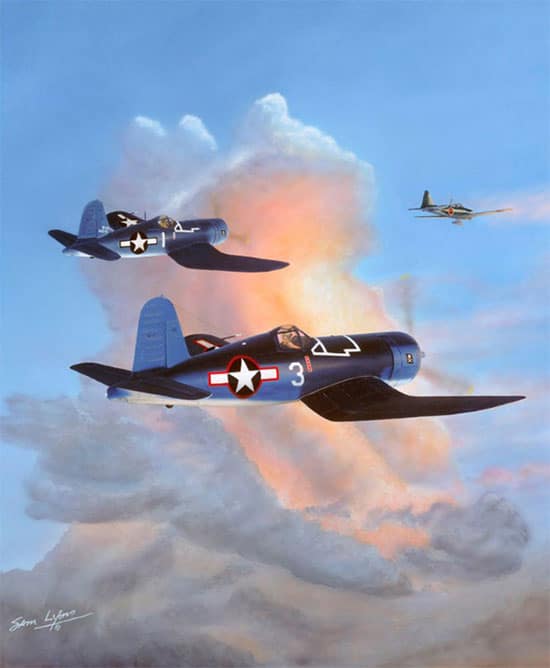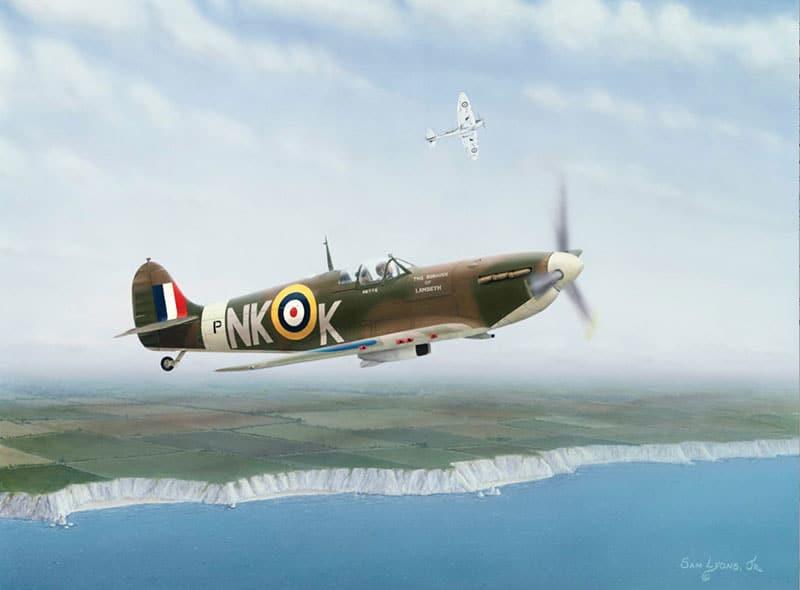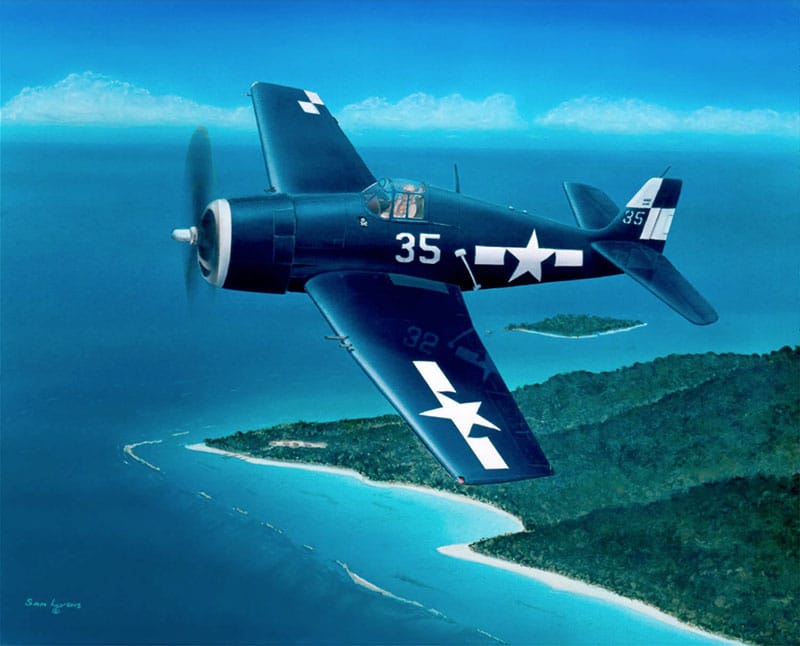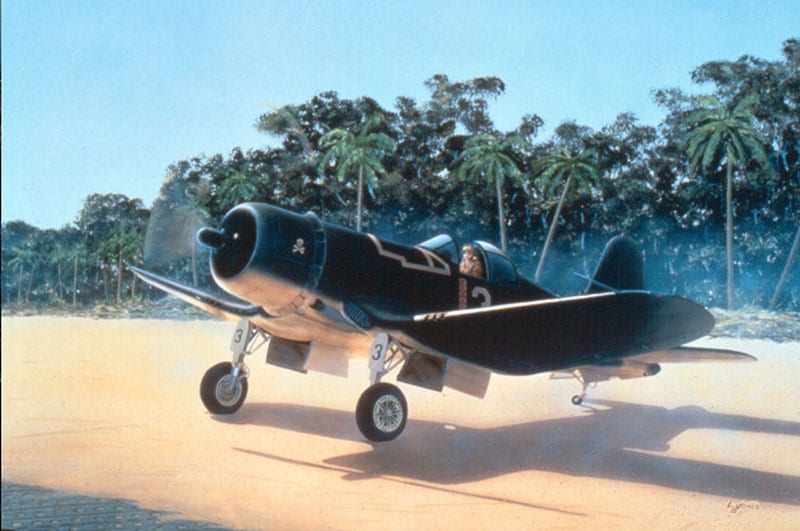Description
Here’s a dramatic scene out of WWII. A pair of F4U Corsairs from the “Jolly Rogers” are pursuing a Japanese Zero with golden sunlight giving the clouds a brilliant glow. The careful observer will know the time frame is around 1943 because of the Corsair markings. The plane in the foreground has red markings. Those were changed to blue that year to avoid confusion with red markings on enemy aircraft. You can see the plane in the background has been switched to blue markings. Ace pilots Jim Streig is the pilot in the number 3 plane, and Tommy Blackburn sits in the cockpit of number 1. Both men were members of the Jolly Rogers, Fighting Squadron 17.
About the Vought F4U Corsair
This info is taken from the National WWII Museum New Orleans website article: Vought F4U Corsair.
Development of the F4U Corsair began in early 1938, headed-up by Vought Aircraft’s Chief Engineer, Rex Biesel. By May 1940, Vought had produced a prototype; the new fighter’s inverted gull wings gave the aircraft an unmistakably recognizable face when viewed head-on, and were designed to provide ground clearance for the massive 13-foot propeller. On the Corsair’s maiden flight, she broke the speed record for a single-seat fighter aircraft by exceeding 400 miles per hour in level flight. The Navy was sold on the speedy fighter and ordered Vought to begin production. Nearly 13,000 examples would be produced by the end of the F4U’s production run in 1952.
The F4U Corsair entered combat in 1943, and gave Allied naval aviators a winning edge against their opponents. Renowned for its speed, ruggedness, and firepower, the Corsair excelled as both a fighter and an attack aircraft in support of ground forces. The F4U-4, with its more powerful engine, was the last Corsair variant to see service during World War II.
Fighter Squadrons with the F4U Corsair
The Jolly Rogers unit, officially Fighter Squadron 17 (VF-17) was formed in January 1943 in Norfolk, VA. It was also known as the 90th bombardment group and part of the 90th U.S Air Force Missile Wing during WW2. The unit commander was Tom Blackburn. The unit was sent to the Solomon Islands in October 1943. On 8 November 1943 the squadron Executive Officer, Roger Hedrick, led a flight which intercepted 39 Japanese fighters over Empress Augusta Bay, Bougainville. As the Japanese fighters fled back to their base, VF-17 was responsible for downing 3 fighters and damaging 4 others. Though outnumbered, the squadron survived the encounter with no losses. This action was typical of the squadron’s land-based service in the Solomon Islands in 1943 and 1944, when it went up against the cream of Imperial Japanese Navy pilots then based at Rabaul. A brief reunion with Bunker Hill occurred during the carrier strike on Rabaul 11 November, when the F4Us landed aboard to refuel and rearm after helping repel a land-based air attack.
About the Japanese Zero, a famous plane of WWII
Info taken from an article on War History Online: Most Famous Japanese Plane of WWII – 15 Facts About the Mitsubishi Zero:
The Zero was designed to meet a tough set of specifications set down by the Japanese Navy in 1937. The new plane had to have a top speed in excess of 310mph (about 499kmph) and reach an altitude of 9840 feet (almost 3,000 meters) in three and a half minutes. It also had to have better maneuverability and range than any existing fighter, as well as carry two machine guns and two cannons.
Mitsubishi was the only company to offer a solution, with a design team led by Jiro Horikoshi. The prototype Zero first took flight on April 1st, 1939. On the 14th of September, it was accepted into service as the A6M1 Carrier Fighter. The first Zeros were powered by a relatively lightweight engine that minimized the weight of the plane. Later on, these were replaced by Nakajima Sakae 925hp radial engines. The Sakae was a little heavier and larger, but more than compensated for this with extra power. The plane far exceeded the Navy’s expectations.
Many Japanese military vehicles were named for the year in which their production began. This pattern extended to Navy fighters. The Zero entered full production in 1940 AD, equivalent to the year 2600 in the Japanese calendar. Based on this, it was given the name Zero-Sen – Type Zero.
As the Zero was being prepared for production, Japan was embroiled in an invasion of China. As the Chinese put up increasingly stiff resistance, the Navy asked for early Zeros to be sent to China. It was here that they saw their first use in combat in August 1940. In the skies above Chungking, 15 Zeros shot down all the Chinese fighters sent against them – a very promising start for Mitsubishi’s creation. Intelligence about the impressive new fighter quickly reached the American government. However, they largely ignored this information until after the attack on Pearl Harbor in December, 1941. As a result, the Americans missed out on a year of planning.
The Zero was the first naval plane to become a seaborne plane that could reliably beat land-based fighters. This made it a particularly intimidating foe, one that Allied pilots struggled against. In the early days of the war in the Pacific, it seemed to the Allies that the Japanese must have had an endless supply of Zeros. They appeared in every major battle, tearing holes in Allied air forces. In reality, the Japanese had fewer than 500 Zeros by December, 1941, but they were working on making more. Over the course of the war, Mitsubishi manufactured 3,879 Zeros. In addition, Nakajima made a further 6,215, and Sasebo, Hitachi, and Nakajima produced 844 between them – a total of 10,938 planes.
In 1943, the tables were turned. The Allies, who had been frantically improving their fighter designs, started fielding planes with more powerful engines and better armor. The Zero, which had barely changed in four years, had little protection against harder-hitting weapons and better-moving planes. The Zero went from winning most confrontations to losing them.
Having lost much of its value as a fighter, the Zero was the first plane to be used in kamikaze (“divine wind”) attacks. Loaded with explosives, Zeros were turned into flying bombs for suicide attacks against Allied targets. Following the first successes, entire kamikaze teams were formed, with Zeros as their most popular planes. Once the best weapon in the air, the mighty Zero could now only win by destroying itself.
About the Prints
The image size is 18.5″ x 15.5″ and prints are available in a Limited Edition of 250 Signed and Numbered and 25 Artist Proofs.
Similar Sam Lyons Corsair themed prints on this website:
Pacific Sunrise
Evening Return




Reviews
There are no reviews yet.